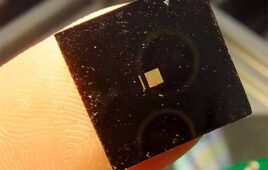
Rendering of the two designs of Dartmouth University researchers’ cardiac energy-harvesting device. (Art by Patricio Sarzosa.)
The heart’s motion is so powerful that it can recharge lifesaving cardiac devices, according to new research from Dartmouth College.
Engineers at Dartmouth’s Thayer School of Engineering developed a dime-sized device to convert the heart’s kinetic energy into electricity to power a wide range of implantable devices, according to the Hanover, N.H.-based college.
Pacemaker and defibrillator batteries must be replaced surgically every five to 10 years. The team’s work proposes modifying pacemakers to harness the kinetic energy of the lead wire that’s attached to the heart, converting it into electricity to continually charge the batteries.
The added material is a type of thin polymer piezoelectric film called “PVDF” and, when designed with porous structures — either an array of small buckle beams or a flexible cantilever — it can convert even small mechanical motion to electricity. The same modules could also potentially be used as sensors to enable data collection for real-time monitoring of patients, according to a university statement.
“We’re trying to solve the ultimate problem for any implantable biomedical device,” said Dartmouth engineering professor John X.J. Zhang, a lead researcher on the study that his team completed alongside clinicians at the University of Texas in San Antonio. “How do you create an effective energy source so the device will do its job during the entire life span of the patient, without the need for surgery to replace the battery?”
“Of equal importance is that the device not interfere with the body’s function,” added Dartmouth research associate Lin Dong, first author on the paper about the three-year study. “We knew it had to be biocompatible, lightweight, flexible, and low-profile, so it not only fits into the current pacemaker structure but is also scalable for future multi-functionality.”
An article on the study appears in Advanced Materials Technologies.
Major medtech companies have already expressed interest in the technology, according to Zhang. The two remaining years of National Institutes of Health funding plus time to finish the pre-clinical process and obtain regulatory approval put a self-charging pacemaker approximately five years out from commercialization.
“We’ve completed the first round of animal studies with great results which will be published soon,” Zhang added.
Other key collaborators on the study include Dartmouth engineering professor Zi Chen, an expert on thin structure mechanics, and Marc Feldman, M.D., professor and clinical cardiologist at UT Health San Antonio.





I was a pacemaker and ICD rep for 40 years and retired recently. This is an important advance in implantable cardiac devices. The infection rate for pacemaker replacements is 5 times that of an initial implant. This would be worthwhile for that reason alone. Saving additional surgeries would be very much appreciated by device patients. I wish you success in developing this technology to a commercial and regulatory approved product.